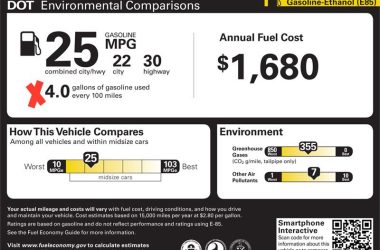The gas guzzler tax is an excise tax imposed by the U.S. federal government on the manufacturers or importers of passenger vehicles that do not meet the required fuel economy standards. It is intended to discourage the production and purchase of fuel-inefficient vehicles and to encourage more fuel-efficient vehicle design.
The tax was established in 1978 as part of the Energy Tax Act and applies to new passenger cars sold or leased in the United States. The goal is to incentivize automakers to improve fuel efficiency across their vehicle lineups and consumers to choose more efficient models, thereby reducing fuel consumption and greenhouse gas emissions.
History
The gas guzzler tax was first introduced in the United States in 1978 as part of the Energy Tax Act, which was passed by Congress as part of the National Energy Act. The objective of this law was to shift away from dependence on foreign oil and gas by incentivizing more fuel efficient vehicles.
The 1970s energy crisis, driven by an oil embargo against the US along with substantial increases in oil prices by OPEC nations, highlighted the risks of America’s dependence on foreign oil. In response, the gas guzzler tax was introduced to discourage the production and purchase of fuel inefficient vehicles. Vehicles that did not meet certain fuel economy standards were subjected to an added tax upon purchase. This aimed to steer consumers toward more efficient vehicles and reduce national fuel consumption.
The gas guzzler tax went into effect in 1980, initially targeting only the worst fuel economy performers. Over time, the standards and tax amounts were increased to apply to more vehicle models. The tax has remained in effect since its introduction over 40 years ago as an early policy measure to improve national fuel efficiency.
Vehicles Subject to the Tax
The gas guzzler tax applies to new passenger cars that do not meet certain fuel economy ratings set by the EPA. The EPA calculates the combined city/highway fuel economy rating for every new car model sold in the United States. Cars with a rating below 22.5 miles per gallon are subject to the gas guzzler tax.
The tax thresholds are more lenient for light trucks, including most SUVs, minivans and pickup trucks. For the 2022 model year, trucks with a fuel economy rating under 21.4 mpg are subject to the tax. Heavier light trucks have an even lower threshold of 17.5 mpg.
Electric vehicles and other zero-emission vehicles are exempt from the gas guzzler tax since they use no gasoline. Hybrid models are also generally exempt because of their improved fuel efficiency.
How the Tax is Calculated
The Gas Guzzler Tax is calculated based on fuel economy ratings from the Environmental Protection Agency (EPA). The EPA calculates the combined city and highway fuel economy ratings for each vehicle model in miles per gallon (MPG).
The tax rate is determined by a formula based on these MPG ratings. Vehicles with a combined fuel economy rating of 22.5 MPG or higher are exempt from the tax. For vehicles below 22.5 MPG, the tax starts at $1,000 and increases $100 for every MPG below 22.5 MPG.
For example, a vehicle with a combined 20 MPG rating would be taxed at $1,000 + $200 (for the 2.5 MPG below 22.5 MPG) for a total of $1,200. The maximum tax is $7,700 for vehicles with a combined fuel economy of 12.5 MPG or lower (Source).
This formula allows the tax rate to scale progressively based on just how fuel inefficient the vehicle is. The worse the fuel economy, the higher the tax penalty. The tax aims to discourage the production and purchase of very gas-guzzling vehicles.
Tax Amounts
The gas guzzler tax is applied on a sliding scale based on the fuel economy rating of a vehicle in miles per gallon (MPG). The lower the MPG, the higher the tax amount. Here’s an overview of the tax amounts:
Vehicles with a fuel economy of 22.5 MPG or higher are not subject to the gas guzzler tax.
For vehicles with fuel economies between 21.5 MPG and 22.5 MPG, the tax is $1,000.
For each MPG below 21.5 MPG, the tax increases by $100. For example:
– 21 MPG: $1,300
– 20.5 MPG: $1,400
– 20 MPG: $1,500
The maximum gas guzzler tax is $7,700 for vehicles with a fuel economy of 12.5 MPG or lower.
The specific tax amount is determined by the EPA fuel economy rating for each vehicle model and configuration. Automakers are required to pay the tax upfront based on these ratings.[1]
Paying the Tax
The gas guzzler tax is paid by the manufacturer or importer of the vehicle, not the consumer who purchases the vehicle. The tax is assessed only one time on a vehicle, at the time it is manufactured or imported into the United States. Used vehicles are not subject to the gas guzzler tax.
According to the EPA, “The tax is imposed on a manufacturer at the time a gas guzzling automobile is first sold by the manufacturer.” The tax amount is based on the fuel economy rating of each model and the number of cars sold at each fuel economy rating level. Manufacturers must pay the IRS on a quarterly basis based on their sales for that period.
So in summary, the gas guzzler tax is paid by automakers and importers when they first manufacture or import new vehicles that fall below the fuel economy standards set by the EPA and NHTSA. Consumers do not directly pay the tax, but may see the cost reflected in the final sticker price of new gas guzzling car models.
Exemptions
Certain vehicles are exempt from the gas guzzler tax. This includes trucks, minivans, and SUVs since they are classified as light trucks by the EPA. Vehicles like the Honda Odyssey minivan and the Toyota 4Runner SUV do not pay the tax, even if they have poor fuel economy.
Additionally, limousines that weigh over 6,000 pounds are exempt. This includes stretched limousines used for airport transfers and corporate transportation. Other exempted vehicles include emergency vehicles like ambulances and police cars.
One of the more controversial exemptions is for electric vehicles. Even though electric cars like the Tesla Model S have very poor efficiency when accounting for the energy used to charge them, they do not pay any gas guzzler tax. This exemption has been criticized as an unnecessary subsidy for electric vehicles.
There have been proposals to remove some of the exemptions and broaden the gas guzzler tax to include more vehicle categories. However, automakers have lobbied heavily against these changes since trucks and SUVs are some of their most profitable vehicles. As of now, the exemptions remain in place.
Sources:
https://www.epa.gov/fueleconomy/gas-guzzler-tax
https://www.capitalone.com/cars/learn/finding-the-right-car/what-is-the-gas-guzzler-tax/1656
Effectiveness
The gas guzzler tax was implemented in 1978 with the goal of discouraging the production and purchase of fuel-inefficient vehicles in order to reduce fuel consumption and dependence on foreign oil. However, the effectiveness of the tax has been debated.
On one hand, some argue the tax has not been effective because it has failed to substantially change consumer behavior or reduce gas consumption. The tax amounts are generally small compared to the sticker price of vehicles, so may not factor heavily into purchase decisions. Additionally, trends like increased truck and SUV sales indicate many consumers still prioritize size, power and performance over fuel economy.
Others note the tax may have had some positive impacts, even if limited. For example, it has encouraged automakers to improve fleet fuel economy to avoid the tax. The increasing prevalence of hybrid and electric vehicles also suggests a cultural shift towards valuing efficiency. However, the extent to which the tax directly spurred these changes is unclear.
Overall, the gas guzzler tax appears to have had modest and indirect effects at best. Larger market forces like gas prices and consumer preferences likely play a bigger role than the tax alone. There are debates around whether the tax should be increased or eliminated entirely.
Sources:
https://www.capitalone.com/cars/learn/finding-the-right-car/what-is-the-gas-guzzler-tax/1656
https://www.epa.gov/fueleconomy/gas-guzzler-tax
Revenue Generated
The Gas Guzzler Tax has generated significant revenue for the U.S. government since its inception. According to statistics from the Internal Revenue Service cited in EPA data, the Gas Guzzler Tax generated $283 million in fiscal year 2022 and has brought in over $11 billion total since 1980. The tax revenue tends to fluctuate year to year based on new vehicle sales and the mix of fuel efficient versus gas guzzling models. Revenue hit a peak in fiscal year 2013 at nearly $500 million when gas prices were high. The gas guzzler tax provides a way for the largest and least fuel efficient passenger vehicles to offset their extra environmental impact through an additional tax at the point of sale.
Future Outlook
There have been proposals to update and expand the Gas Guzzler Tax given the shifting auto market and increased focus on fuel efficiency and emissions reductions. Some lawmakers have suggested removing the exemption for light trucks, SUVs, and minivans, as well as potentially lowering the fuel economy thresholds for being subject to the tax. The Kelley Blue Book notes that there is growing support for a “gas guzzler tax 2.0” that would apply to more vehicle types.
However, opposition from automakers and questions around how effective the tax has been at changing consumer behavior could make major changes difficult. Given the rapid shift towards electric vehicles already underway, some expect the relevance of the Gas Guzzler Tax to naturally decline over time without the need for amendments. According to the EPA, revenues from the tax have fallen substantially in recent years as more efficient vehicles enter the market.




